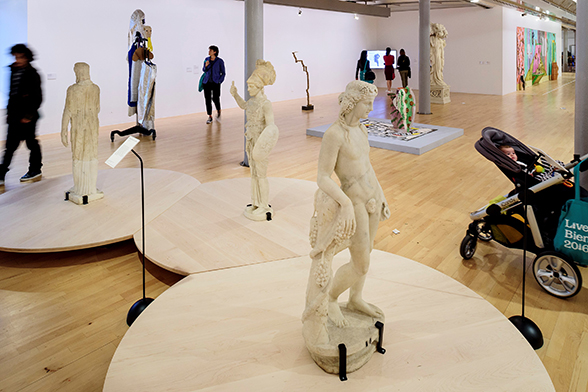Koenraad Dedobbeleer: Re-imagining Barriers to Art
Posted on 1 September 2016 by Guest Blogger
Statue of Apollo Sauroktonos. © Tate Liverpool, Roger Sinek
What happens when we reimagine the way artwork is displayed? Sufea Mohamad Noor takes a closer look at one of Koenraad Dedobbeleer’s contributions to this year’s festival.
Barriers in an exhibition are great for protecting artworks from naughty hands but can be an absolute eyesore. I’m sure that many people, like me, have had the experience of admiring a beautiful painting or a majestic sculpture ruined because those dull barriers keep getting in the way. This gallery item is usually grey in colour and often sits at an awkward height, optically slicing through the bottom parts of artworks.
Seeing Koenraad Dedobbeleer’s re-contextualisation of a number of artworks at Tate Liverpool as part of Liverpool Biennial 2016 was a wonderful surprise. The Belgian artist is interested in the history of an object in relation to the culture that it is linked to, and so has made structures to change our physical behaviour. These structures are a simple combination of metal pipes in bubblegum pink and unfinished timber surfaces. Some take the form of circular railings around artworks, while others look like alternative designs for the traditional plinth or, to put it simply, oversized tables.
What is so effective about these structures is the way they create a physical distance between the artworks and the public, without making the viewer feel barricaded from the objects on display. The railings allow us to look beyond them and into the space inside, inviting us to appreciate the objects they protect from top to bottom. Their circular shape makes walking around the sculptures seem natural, and actually encourages you to look from different angles, rather than instructing you to keep a distance.
The tables behave in a similar manner. In the middle of each is an Ancient Greek vase, and the tables are attached in a caterpillar-like shape. Maybe the reason Dedobbeleer morphed these displays is because he wants us to look at the sculptures as a set, instead of only paying attention to the pieces that we naturally gravitate towards. Or perhaps the reason is just that the artist wanted to keep in line with the hermaphrodite theme of the Ancient Greece episode – where lots of disparate parts are brought together.

L-R Statuette of Tyche 1st Century AD, Archaistic Statuette of Athena 1st Century AD and Statue of Dionysos. © Tate Liverpool, Roger Sinek
Another conventional gallery item that Dedobbeleer has altered is the display of texts written to accompany the artworks in the exhibition. The traditional foam cards stuck to the wall, or paper encased in Perspex, would be no good for artefacts displayed inside bespoke barriers and on custom-made plinths. Instead, the accompanying interpretation panels are propped against sleek black sign holders, reminiscent of a microphone stand. The minimal design complements the pink railings and the unfinished timber table tops. Together they present classical objects in a fresh, contemporary way. They are also great to look at as objects in their own right.
Dedobbeleer’s contribution to this year’s Biennial highlights the extent to which run-of-the-mill gallery items can affect the viewer’s experience of the work. The ideal would be to tailor the display for every exhibition: protecting the artwork whilst providing a source of visual delight and seamless, non-verbal way of enriching a gallery visit.
Words by Sufea Mohamad Noor
How have methods of display shaped your experience of Liverpool Biennial, or of art in general? Let us know in the comments section below.
Liverpool Biennial
55 New Bird Street
Liverpool L1 0BW
- T +44 (0)151 709 7444
- info@biennial.com
Liverpool Biennial is funded by
Founding Supporter
James Moores
